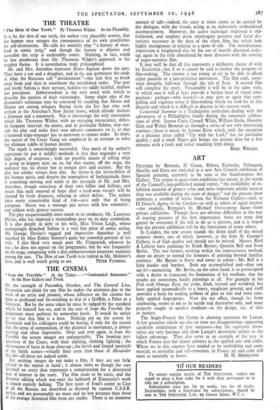THE CINEMA
ON the strength of Potemkin, October, and The General Line, Eisenstein can claim for any film he makes the attention due to the work of an artist and pioneer, whose influence on the cinema has been as profound and far-reaching as that of a Griffith, a Pabst or a Grierson. But by the same token he must be judged by the standard which he himself has set, and in the case of Ivan the Terrible the judgement must perforce be somewhat harsh. It would be unfair to say that this film is a bore. Nothing put on the screen by Eisenstein and his colleagues could be boring, if only for the reason that the sense of composition, of the pictorial in movement, is always exciting and often impressive. Over and over again in Ivan the Terrible the screen images are unforgettable. The looming per- spectives of the Court, with their slanting, slashing lighting ; the chiaroscuro of faces in huge dose-up ; the lavish and limpid spectacle of the battle scenes—visually finer even than those of Alexander Nevski—all these are indeed noble.
But exciting images do not make a film, if they are not fully related to the matter in hand ; it almost looks as though the care lavished on every shot represents a compensation for a directorial lack of interest in the story. The film tends to be static, and the dynamic editing which was once the hallmark of Eisenstein's work is almost entirely lacking. The first years of Ivan's career as Czar of all the Russias are described as dictated by current U.S.S.R. Policy, and are presumably no more and no less accurate than those of the average historical film from any studio. .There is an immense amount of talk—indeed, the story at times seems to be carried by the dialogue, with the visuals acting as an elabor ately embroidered accompaniment. Moreover, the active technique employed is old- fashioned, and employs those extravagant gestures and facial dis- tortions necessary in the days of the silent film, but which look highly incongruous in relation to a spate of talk. The melodramatic impression is heightened also by the use of heavily plastered make- up, again in the style abandoned by most directors with the coming of super-sensitive film.
It may well be that all this represents a deliberate choice of style by Eisenstein' but if so it cannot be said to further the progress of film-making. The cinema is too young an art to be able to afford either pastiche or a neo-primitive movement. The film ends, some- what abruptly, half-way through the tale of Ivan. A second film will complete the story. Presumably it will be in the same style, in which case it will at least provide a further feast of visual com- position: perhaps—who knows?—it may give us again that com- pelling and vigorous sense of film-making which we look for in this director and which it is difficult to discern in his current work.
Centennial Summer is a Technicolor confection dealing with the adventures of a Philadelphia family during the centenary celebra- tions of 1876. Jeanne Crain, Cornell Wilde, William Eythe, Dorothy Gish and Walter Brennan go through a series of not very interesting routines ; there is music by Jerome Kern which, with the exception of a pleasant piece called " Up with the Lark," has no particular quality ; and a small Negro girl brings the picture alive for a few minutes with a fresh and rather touching little dance.
BASIL WRIGHT.


























 Previous page
Previous page